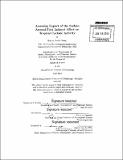| dc.contributor.advisor | Kerry A. Emanuel. | en_US |
| dc.contributor.author | Chang, Hao-yu Derek | en_US |
| dc.contributor.other | Massachusetts Institute of Technology. Department of Earth, Atmospheric, and Planetary Sciences. | en_US |
| dc.date.accessioned | 2015-09-17T19:04:04Z | |
| dc.date.available | 2015-09-17T19:04:04Z | |
| dc.date.copyright | 2015 | en_US |
| dc.date.issued | 2015 | en_US |
| dc.identifier.uri | http://hdl.handle.net/1721.1/98675 | |
| dc.description | Thesis: S.M., Massachusetts Institute of Technology, Department of Earth, Atmospheric, and Planetary Sciences, 2015. | en_US |
| dc.description | Cataloged from PDF version of thesis. | en_US |
| dc.description | Includes bibliographical references (pages 69-75). | en_US |
| dc.description.abstract | Tropical cyclones (TCs) are among the most expensive and lethal geophysical hazards. Studies suggest that the intensity of TCs will increase due to the thermodynamic effects of anthropogenic greenhouse gas input. In contrast, while aerosols are shown to have an overall cooling effect on global climate, their impact on TCs is not yet well-understood. This paper explores the influence of the sulfate aerosol first indirect effect (AIE) on Atlantic hurricane intensity and genesis. I use a single-column radiative convective model that incorporates the first AIE (aerosol enhancement of cloud reflectivity) through parameterization of cloud droplet number, radius, and optical depth. Cloud droplet number is parameterized using an empirical scheme, while the radius is determined from cloud liquid water content and number concentration moments, and the optical depth scheme is embedded in the original single-column model. The model is run with both the IGAC/SPARC Chemistry Climate Model Initiative (CCMI) historical simulations of sulfate concentrations over the hurricane main development region during hurricane peak season (August-October) and a self-generated inventory of sulfate concentrations based on realistic vertical variability in sulfate levels. The model was run to radiative-convective equilibrium (RCE), then rerun under weak temperature gradient mode (WTG). Runs successfully produce the Twomey or first indirect effect, which states that increased aerosols will increase cloud droplet number concentration, decrease the effective cloud droplet radius, and increase the cloud optical depth. The net effect is increased reflection of radiation from the atmosphere, which theoretically cools the Earth, decreasing the potential intensity and genesis potential of TCs. While model runs produce the expected changes in cloud properties, cloud cover is not sufficient for sulfate concentrations to have a substantial impact on hurricane activity via the AIE when the model is run to RCE. The WTG mode is then implemented with the goal of producing low-lying stratocumulus clouds to increase total cloud cover, but the single-column WTG scheme was not able to produce stratocumulus that did not also produce an overly strong negative feedback. Using the single-column model, one can demonstrate the indirect effect of sulfate aerosols on cloud reflectivity and that sufficient cloud cover is needed to produce a noticeable cooling and change in expected hurricane behavior. A further study of the subject could include parameterization of the poorly-understood cold or mixed-phase clouds, which can include characterization of additional aerosol types. In addition, a two-dimensional model has greater capacity to model phenomena such as low-lying stratocumulus, which could produce a more substantial ambient effect. | en_US |
| dc.description.statementofresponsibility | by Hao-yu Derek Chang. | en_US |
| dc.format.extent | 75 pages | en_US |
| dc.language.iso | eng | en_US |
| dc.publisher | Massachusetts Institute of Technology | en_US |
| dc.rights | M.I.T. theses are protected by copyright. They may be viewed from this source for any purpose, but reproduction or distribution in any format is prohibited without written permission. See provided URL for inquiries about permission. | en_US |
| dc.rights.uri | http://dspace.mit.edu/handle/1721.1/7582 | en_US |
| dc.subject | Earth, Atmospheric, and Planetary Sciences. | en_US |
| dc.title | Assessing impact of the sulfate aerosol first indirect effect on tropical cyclone activity | en_US |
| dc.type | Thesis | en_US |
| dc.description.degree | S.M. | en_US |
| dc.contributor.department | Massachusetts Institute of Technology. Department of Earth, Atmospheric, and Planetary Sciences | |
| dc.identifier.oclc | 920682564 | en_US |
